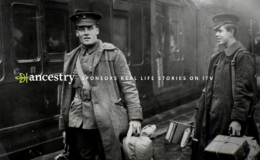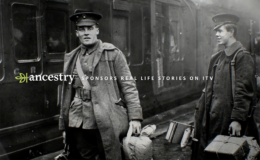

This is an undated photo of an illustration of pre-Civil war life depicting African men in slave pens in Washington D.C. circa 1849-1850. (AP/AP)
When Ancestry.com unveiled an advertisement last month that seemed to romanticize slavery, the multibillion dollar genealogy company was roundly criticized.
The video, which was posted to YouTube and aired on television in Utah, where Ancestry.com is based, featured a young white man in 19th-century clothing holding out a ring to a black woman. “Abigail, we can escape to the North,” he tells her, interrupting as she attempts to respond. “There is a place we can be together across the border.”
The ad — a concocted story not based on an actual couple — seems to suggest that black people can find meaning and belonging, if not power and beauty, by learning that they are descended from white people. “Uncover the lost chapters of your family history with Ancestry,” the ad implores, ending with a document suggesting the couple married in Canada in 1857.
After the transatlantic slave trade ended in 1808, more than a million enslaved people in the United States were forcibly moved south, most of them through the domestic, or downriver, slave trade. An untold number of families were separated as a result, including children who were sold away from their parents and siblings, never to be seen again. The displacement was driven by an insatiable demand for labor in the cotton-producing South.
The experience of being sold and ripped away from loved ones was only part of the trauma. America’s history of slavery goes hand-in-hand with a history of rape. Masters and their overseers routinely raped enslaved women and girls, resulting in multiracial babies who, following the condition of their mother, were also born enslaved. Life as an enslaved person in America also meant being forced to work against one’s will and limitations on most personal liberties.
But fleeing north to find freedom was a dangerous prospect that could result in kidnapping, violent punishment or even death.
In attempting to market genealogy as nostalgia, Ancestry.com has at times been insensitive to this often traumatic history.
A basic tenet of genealogical research is that white Americans can more easily trace their European ancestors, while black Americans often face a “ brick wall” — a dearth of records before emancipation. Because enslaved people were considered property until after the Civil War, many enslaved people’s full names and identifying information are not included in documents that white Americans can use to track ancestors, such as annual census counts. But Ancestry.com’s attempt to provide context often does not take into account that white and black histories are fundamentally different.
Doing research for a book, I built a family tree for an enslaved girl who was sold from Richmond, Va., and shipped to New Orleans. I saved primary documents I found on Ancestry.com to create a timeline of her life. To accompany this timeline, Ancestry.com attempted to contextualize her “LifeStory” by suggesting she might have “participated in parades and balls as Mardi Gras traditions were first established in New Orleans” — as though she were a free woman. But this erases the stark differences in the lives of free women and enslaved women: As a slave, she was not even free to come and go as she chose.
Ancestry.com does not account for the harsh realities of life as an enslaved person in other ways as well. It exclusively refers to the two parents of a child as spouses, even when the genealogist denotes “partner” or “other.” When I added the birth of an enslaved girl’s first child at 13 in another family tree, the website questioned whether the information was correct. “The birth date is before the mother’s childbearing age,” it asks. “Are you sure?”
The site does not appear to have a mechanism to account for slave rape. A study conducted by Kasia Bryc at the competing genealogy website 23andMe found that the average self-identifying African American is about 24 percent European, or white. Ancestry also doesn’t seem to allow in any measurable way for the fact that enslaved people were not legally permitted to marry and that they were often torn away from their chosen spouses and their children by the slave trade.
To be sure, Ancestry.com has done much good for black Americans researching their family histories, regularly uploading records and indexes that trace early life for black Americans. Ancestry.com has also created an African American research guide and partnered with prominent historian and “Finding Your Roots” producer Henry Louis Gates Jr. to promote its subscription service that provides access to more than 20 billion records.
Yet on some basic level, the company has failed to address that life for black and white people in America has always been radically different, especially prior to the Civil War. When queried about these issues, Ancestry.com spokeswoman Gina Spatafore told The Washington Post, “We recognize family dynamics and non-familial relationships are complex and we are continuing to innovate and advance our functionality to more accurately represent various relationships in trees and bear witness to moments in history.” The company also noted that the “LifeStory” function can be turned off by users.
As Ancestry.com attempts to address these issues, it needs to take some clear steps: first, the site can start by changing the automatic spouse designation and eliminating prompts that correct for maternal age, which ignore the awful realities of slave life. The company also could take a look at the diversity of its workforce, 73 percent of whom live in Utah and are likely overwhelmingly white. A staff that reflects America’s racial makeup could help it avoid missteps like the “Inseparable” ad. Spatafore did not respond to questions about the diversity of its employee pool.
Most importantly, the company should stop interpreting its own records for users. The way it currently presents context on black lives does a terrible disservice to African Americans looking for information about their past. When news about the advertisement first broke, the company told media outlets that “Ancestry is committed to telling important stories from history.” But its three million paid subscribers would be better served if Ancestry.com let people use its documents to tell their own stories.














